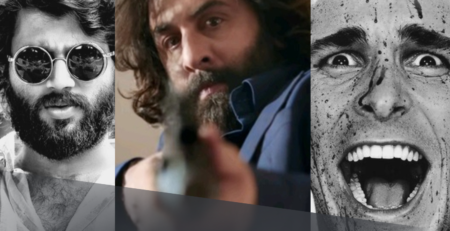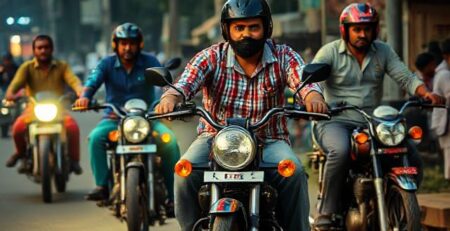Nostalgic Tamil Cinema Bike Scenes: Iconic Motorcycles That Created Cinematic History
What Makes Tamil Cinema Bike Scenes So Memorable?
Tamil cinema has always shared an intimate relationship with motorcycles, transforming these machines from mere transportation into powerful storytelling devices. Hindi cinema has always had a strong relationship with two-wheelers especially motorcycles, but scooters and even mopeds have featured in some memorable sequences over the years. Bollywood has used them as much more than mere props, at times to add machismo, other times as an integral part of the personification of character being depicted. This relationship extends deeply into Tamil cinema, where bikes become extensions of characters’ personalities and central elements of narrative progression.
The visual poetry created when skilled cinematographers capture motorcycles in motion has contributed significantly to Tamil cinema’s distinct aesthetic. These scenes often combine technical precision with emotional storytelling, creating moments that resonate with audiences long after leaving theaters. From high-octane chase sequences to romantic rides through scenic landscapes, motorcycles have provided filmmakers with versatile tools for visual expression.
Which Tamil Movies Featured the Most Iconic Motorcycle Moments?
Polladhavan (2007): The Yamaha RX100 Revolution
Polladhavan (transl. Ruthless Man) is a 2007 Indian Tamil-language action thriller film written and directed by Vetrimaaran in his directorial debut. Starring Dhanush and Ramya, the film revolves around a man whose life improves after buying a bike, and turns upside down after it is stolen. This groundbreaking film elevated the humble motorcycle from supporting prop to central character, with the Yamaha RX100 serving as both symbol and catalyst for the protagonist’s transformation.
The RX100’s significance extends beyond its screen presence. The Yamaha RX 100 was a two-stroke motorcycle made by Yamaha from 1985 to 1996 with technical collaboration and distributed in India by the Escorts Group. This motorcycle represented freedom, aspiration, and youth culture during its production years, making it the perfect choice for Polladhavan’s narrative about a young man’s dreams and struggles.
Director Vetrimaaran’s genius lay in understanding how the bike’s theft could metaphorically represent the crushing of dreams and dignity. The film’s bike sequences, particularly the moments showing the protagonist’s initial joy and subsequent desperation, created some of Tamil cinema’s most emotionally resonant motorcycle scenes. The RX100’s distinctive two-stroke engine sound became almost musical in the film’s audio design, contributing to its nostalgic appeal.
STR’s Musical Journey with Royal Enfield
Silambarasan’s (STR) films have consistently featured Royal Enfield motorcycles, creating a signature aesthetic that combines music, motion, and mechanical beauty. The song “Thalli Pogathey” showcased how Royal Enfield’s classic design could enhance romantic storytelling, with the motorcycle serving as both transportation and metaphor for life’s journey.
Royal Enfield motorcycles bring inherent advantages to cinematic storytelling. Their robust build, distinctive exhaust note, and timeless design create visual and auditory elements that enhance any scene’s dramatic impact. The brand’s heritage and association with adventure perfectly complement Tamil cinema’s storytelling traditions, where characters often embark on transformative journeys.
The cinematographic possibilities offered by Royal Enfield motorcycles include their photogenic qualities in various lighting conditions, their ability to navigate diverse terrains for location shooting, and their symbolic representation of authenticity and tradition. These factors have made them recurring favorites among Tamil filmmakers seeking to create memorable bike sequences.
How Do Motorcycle Models Enhance Cinematic Visual Experience?
Technical Specifications and Visual Appeal
Different motorcycle models offer distinct visual and auditory characteristics that filmmakers can leverage for specific narrative purposes. Two-stroke engines like the Yamaha RX100 provide sharp, aggressive sounds that suit action sequences and youth-oriented narratives. Four-stroke engines, common in Royal Enfield motorcycles, produce deeper, more resonant tones that complement dramatic and romantic scenes.
The physical design elements of motorcycles contribute significantly to their cinematic appeal. Chrome components reflect light beautifully during day shoots, while LED lighting systems create stunning effects in night sequences. Spoke wheels versus alloy wheels offer different aesthetic choices, with spoke wheels providing vintage charm and alloy wheels suggesting modernity and performance.
Motorcycle positioning within frame compositions allows cinematographers to create dynamic visual narratives. Low-angle shots emphasize power and dominance, while high-angle shots can suggest vulnerability or introspection. The linear design of motorcycles naturally guides viewers’ eyes through frame compositions, making them excellent tools for visual storytelling.
Color Psychology and Brand Identity in Cinema
Motorcycle color schemes significantly impact audience perception and emotional response. Black motorcycles often represent mystery, rebellion, or sophistication, while red suggests passion and energy. Blue conveys reliability and trust, making it suitable for heroic characters. Silver and chrome finishes reflect light dynamically, creating visually striking sequences that enhance production value.
Brand identity plays crucial roles in audience connection and character development. Royal Enfield motorcycles carry connotations of heritage, authenticity, and adventure, making them ideal for characters representing traditional values or embarking on significant journeys. Japanese brands like Yamaha suggest reliability, performance, and modernity, suitable for contemporary urban narratives.
The psychological impact of specific motorcycle models extends beyond visual aesthetics to cultural associations and memories. Many audience members have personal connections to particular bike models, creating immediate emotional engagement when these machines appear on screen. This phenomenon explains why certain motorcycle scenes achieve cult status and generate lasting fan devotion.
What Role Do Bike Songs Play in Tamil Cinema Storytelling?
Musical Integration with Motorcycle Sequences
Tamil cinema’s tradition of integrating songs with motorcycle sequences creates unique storytelling opportunities that combine visual spectacle with musical narrative. These sequences often serve multiple purposes: advancing plot, developing character relationships, showcasing locations, and providing entertainment value. The rhythm of motorcycle engines can complement musical beats, creating synchronized audio-visual experiences that enhance overall impact.
The choreography of motorcycle sequences within songs requires careful coordination between stunt teams, cinematographers, and music directors. Successful integration depends on matching vehicle movement with musical phrasing, ensuring that acceleration, braking, and turning coincide with melodic and rhythmic elements. This synchronization creates seamless entertainment that feels natural rather than forced.
Location selection for bike songs significantly impacts their visual appeal and narrative effectiveness. Coastal roads provide scenic backdrops that suggest freedom and romance, while urban environments offer energy and modernity. Mountain roads create dramatic tension and adventure, making them popular choices for action-oriented sequences. The interplay between motorcycle capabilities and location characteristics helps determine sequence feasibility and visual impact.
Which Motorcycle Models Dominated Different Eras of Tamil Cinema?
The Golden Age: Classic Models and Timeless Appeal
Early Tamil cinema featured motorcycles that reflected the technological and cultural landscape of their times. Bajaj scooters and early Honda models represented middle-class aspirations during the 1970s and 1980s, appearing in family dramas and romantic comedies as symbols of modest success and practical transportation.
The introduction of performance-oriented motorcycles during the 1990s coincided with Tamil cinema’s evolution toward more action-heavy narratives. Yamaha RX100, with its two-stroke engine and aggressive styling, became synonymous with youth rebellion and urban energy. Its distinctive sound and visual appeal made it a natural choice for filmmakers seeking to capture changing social dynamics.
Royal Enfield motorcycles maintained consistent presence throughout different eras due to their timeless design and cultural significance. Their association with heritage and authenticity made them suitable for period films, while their robust construction enabled demanding stunt sequences that other motorcycles couldn’t safely execute.
Modern Era: Technology Meets Tradition
Contemporary Tamil cinema benefits from advanced motorcycle technology that offers enhanced visual and performance possibilities. Modern bikes feature sophisticated lighting systems, digital displays, and refined engineering that create new cinematic opportunities while maintaining connection to traditional storytelling values.
The availability of diverse motorcycle categories allows filmmakers to match vehicles precisely with character personalities and narrative requirements. Sport bikes suggest speed and aggression, cruisers imply leisure and style, adventure bikes represent exploration and capability, while classic designs maintain connection to heritage and tradition.
How Do Stunt Sequences Utilize Different Motorcycle Models?
Safety Considerations and Performance Requirements
Professional stunt coordination requires careful selection of motorcycle models based on their performance characteristics, reliability, and safety features. Stunt bikes must possess predictable handling, adequate power delivery, and robust construction to withstand repeated takes and potential impacts. These requirements often favor specific models that balance performance with durability.
The physical demands of stunt riding necessitate motorcycles with appropriate ergonomics for stunt performers. Handlebar positioning, seat height, and control layout significantly impact rider comfort and control during extended shooting periods. Bikes with adjustable components allow customization for different performers and stunt requirements.
Maintenance accessibility becomes crucial during production schedules where mechanical issues can cause expensive delays. Motorcycles with readily available parts and straightforward servicing procedures provide production advantages that influence model selection decisions. This practical consideration often favors established brands with strong dealer networks.
Choreography and Visual Impact
Stunt choreography must consider each motorcycle model’s capabilities and limitations when designing sequences. High-performance sport bikes excel at speed-based stunts but may struggle with tight maneuvering, while lighter bikes offer agility advantages in confined spaces. Understanding these characteristics enables stunt coordinators to create sequences that showcase each bike’s strengths.
Camera placement and movement coordination require precise timing that depends on motorcycle performance predictability. Consistent acceleration rates, braking distances, and turning radii allow cinematographers to plan camera movements that capture desired angles while maintaining safety margins. This coordination becomes particularly critical during complex sequences involving multiple vehicles.
What Cultural Impact Have These Motorcycle Scenes Created?
Influence on Youth Culture and Motorcycle Enthusiasm
Tamil cinema’s motorcycle scenes have significantly influenced youth culture and motorcycle purchasing decisions throughout South India. Iconic films like Polladhavan sparked renewed interest in vintage models, with many young enthusiasts seeking Yamaha RX100 motorcycles specifically due to their cinematic associations. This phenomenon demonstrates cinema’s power to shape consumer preferences and cultural trends.
The aesthetic preferences established by Tamil cinema have influenced motorcycle modification trends, with enthusiasts recreating looks and sounds featured in favorite films. Custom exhaust systems, paint schemes, and accessory choices often reference specific movie scenes, creating a direct connection between entertainment and automotive culture.
Social media has amplified these influences, with motorcycle enthusiasts sharing recreations of famous scenes and organizing themed rides inspired by Tamil films. This ongoing engagement demonstrates the lasting impact of well-crafted motorcycle sequences on audience imagination and cultural expression.
Economic Impact on Motorcycle Industry
The prominence of specific motorcycle models in successful Tamil films has created measurable economic impacts on manufacturers and dealers. Increased demand following film releases has been documented for various models, from vintage bikes featured in period pieces to modern motorcycles showcased in contemporary action films.
This relationship has led to strategic partnerships between film production companies and motorcycle manufacturers, with brands providing vehicles for productions in exchange for prominent placement and marketing opportunities. These collaborations benefit both industries while providing audiences with authentic product representation.
How Have Filming Technologies Enhanced Motorcycle Cinematography?
Camera Equipment and Mounting Systems
Advanced camera mounting systems have revolutionized motorcycle cinematography in Tamil cinema, enabling shots previously impossible with traditional equipment. Gyroscopic stabilizers allow smooth footage even during aggressive riding, while remote-controlled camera systems provide flexibility without compromising safety.
Drone technology has added aerial perspectives that showcase motorcycles within broader landscape contexts, creating spectacular establishing shots and following sequences that enhance visual storytelling. The ability to capture motorcycles from multiple angles simultaneously provides editors with extensive footage options for creating dynamic sequences.
High-speed cameras enable slow-motion sequences that highlight mechanical details and rider techniques, adding educational and aesthetic value to action scenes. These technological capabilities allow filmmakers to showcase motorcycle performance characteristics while creating visually stunning entertainment.
Digital Effects and Post-Production Enhancement
Digital color grading and visual effects processing enable cinematographers to enhance motorcycle scenes’ visual impact while maintaining realistic appearance. Subtle adjustments to lighting, contrast, and color saturation can dramatically improve footage quality without appearing artificial.
Sound design technology allows precise control over motorcycle audio characteristics, enabling filmmakers to enhance engine sounds, exhaust notes, and environmental acoustics. This audio enhancement contributes significantly to sequences’ emotional impact and audience engagement.
What Future Trends Will Shape Tamil Cinema Motorcycle Sequences?
Electric Motorcycles and Changing Technology
The emergence of electric motorcycles presents both opportunities and challenges for Tamil cinema’s future motorcycle sequences. While electric bikes offer advantages like instant torque delivery and quiet operation, their lack of traditional engine sounds requires creative audio design approaches to maintain audience engagement.
Environmental consciousness and urban pollution concerns may influence future storylines and motorcycle selection, with electric vehicles representing progressive values and environmental responsibility. This shift could create new narrative opportunities while maintaining traditional excitement and visual appeal.
International Influences and Global Distribution
Tamil cinema’s increasing global reach influences motorcycle sequence design, with filmmakers considering international audience preferences and cultural contexts. This globalization may lead to more diverse motorcycle selections and filming techniques that appeal to broader audiences while maintaining regional authenticity.
The integration of international stunt techniques and safety standards continues improving production quality and expanding creative possibilities. Access to global talent pools and equipment resources enables Tamil filmmakers to create motorcycle sequences competitive with international productions.
Conclusion: The Enduring Legacy of Motorcycles in Tamil Cinema
Tamil cinema’s relationship with motorcycles represents more than entertainment; it reflects cultural values, technological evolution, and artistic expression. From the Yamaha RX100’s symbolic power in Polladhavan to Royal Enfield’s romantic presence in countless musical sequences, these machines have become integral elements of Tamil storytelling tradition.
The nostalgic appeal of classic motorcycle scenes continues inspiring new generations of filmmakers and enthusiasts, ensuring this cinematic tradition’s continuation. As technology evolves and new models emerge, Tamil cinema will undoubtedly find innovative ways to incorporate motorcycles into compelling narratives that capture audiences’ imagination and hearts.
The enduring popularity of these iconic scenes demonstrates cinema’s power to transform mechanical objects into cultural symbols, creating lasting connections between entertainment, technology, and human emotion. This transformation ensures that motorcycles will remain prominent features in Tamil cinema’s future, continuing to provide thrilling visuals and meaningful metaphors for generations of storytellers and audiences alike.












